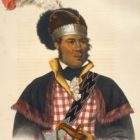McIntosh Road
McIntosh Road
McIntosh Road, also called the McIntosh Trail, is a historic Native American route in the northern part of the U.S. states of Alabama and Georgia. It was named for the prominent Creek Indian chief William McIntosh, a leader of the Lower Towns. He helped improve it in the early 19th century, to connect Creek towns in what are now two states.
The original McIntosh Road, also called, in Alabama, the “Georgia Road”1, led from Kymulga Ferry near Childersburg, Alabama to Talladega, Alabama northeasterly, then traveling along the south side of the Choccolocco Valley and crossing the ridge containing Cheaha Mountain at a pass some miles north. It travels through the area of modern Hollis Crossroads and crosses the Tallapoosa River at an Okfuskee village 2, continuing in a southeasterly direction to the Chattahoochee River near modern Whitesburg, Georgia in Carroll County.
- The Georgia Road, also called the Federal Road, was a toll road opened in 1805 from Savannah, Georgia across Cherokee Indian lands to Knoxville, Tennessee. Branches also extended to Nashville, Tennessee and Huntsville, Alabama. After improvements in 1819 it was renamed the Federal Road. – Editor
- Okfuskee are a Muscogee tribe. They formed part of the former Creek (Muscogee) Confederacy in Alabama, prior to their removal during the 1830s to the Indian Territory. – Editor
The road continues today along its original axis in Talladega and Calhoun counties in Alabama, and the original track virtually disappears as it enters the mountains of Cleburne County. The eastern terminus was at McIntosh’s Ferry, which he operated on the Chattahoochee River near his plantation, known as “Lochau” or “Lockchau Talofau” on Acorn Bluff.
During the last months of the American Civil War, Union regiments under General John T. Croxton used the route to invade Georgia in April 1865.
The road in Alabama can be followed by U.S. Route 431 (US 431), Alabama State Route 21 (SR 21), Talladega County Route 180 (CR 180), and Talladega CR 240, paralleling the Norfolk Southern Railway tracks to the Kymulga Mill And Covered Bridge.
